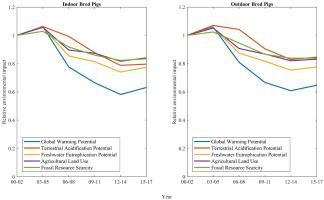Agricultural Systems ( IF 6.1 ) Pub Date : 2021-01-29 , DOI: 10.1016/j.agsy.2021.103063 Mathias Ottosen , Stephen G. Mackenzie , Joao A.N. Filipe , Maciek M. Misiura , Ilias Kyriazakis

|
Context
The aims of global pig production systems include a reduction of their environmental impacts, which can be achieved through an increase in outputs whilst minimising inputs.
Objective
The aim of this paper was to develop a novel method to enable estimation of the changes in the environmental impacts based on sparse data from the British pig production industry over ~20 years.
Methods
To achieve this, we developed a Life Cycle Assessment (LCA) method capable of dealing with sparse historical data from livestock systems. We applied it, for the first time, to estimate the temporal changes in environmental impacts of British pig production systems caused by changes in production performance. Performance data available from industry-held databases for indoor and outdoor bred pigs in Britain were used to estimate nutrient requirements through animal performance modelling, and feed composition through least-cost formulation. The cradle to farm-gate LCA model developed, included manure management and the full life cycle of the pigs and its functional unit was 1 kg of live weight pig at farm-gate. Sensitivity analyses were conducted to investigate the potential influence of changes in animal performance and feed prices on the estimated changes in environmental impacts.
Results and Conclusions
The higher growth rates and increased leanness over the period considered led to substantial reductions in energy requirements. Overall, the system changes led to reductions, for indoor and outdoor bred systems respectively, of 37.0% and 35.4% for Global Warming Potential, 21.2% and 16.4% in Terrestrial Acidification Potential, 22.5% and 22.3% in Freshwater Eutrophication Potential, 15.8% and 16.8% in Agricultural Land Use and 16.5% and 16.1% in Fossil Resource Scarcity. The sensitivity analyses showed that trends in feed composition were influential on the environmental impact outcomes, and that the LCA model was more sensitive to the change in feed composition than to the changes in animal performance over the time period considered.
Significance
Knowledge of temporal changes to the environmental impacts of livestock systems and the drivers of changes to date should guide future decisions to mitigate these impacts.
中文翻译:

过去18年中英国养猪生产系统对环境的影响变化
语境
全球养猪生产系统的目标包括减少其对环境的影响,这可以通过增加产量同时减少投入来实现。
目的
本文的目的是开发一种新方法,该方法能够基于来自英国养猪业近20年的稀疏数据来估计环境影响的变化。
方法
为此,我们开发了一种生命周期评估(LCA)方法,该方法能够处理来自牲畜系统的稀疏历史数据。我们首次将其用于估算生产性能变化对英国养猪生产系统的环境影响的时间变化。可以从英国室内和室外种猪的行业数据库中获得性能数据,通过动物性能模型估算营养需求,并通过成本最低的配方估算饲料成分。建立了从农场到农场大门的LCA模型,包括粪便管理和猪的整个生命周期,其功能单位是农场大门处1千克活重的猪。
结果与结论
在此期间,较高的增长率和稀薄度的增加导致能源需求的大幅减少。总体而言,系统变化导致室内和室外繁殖系统的全球变暖潜势分别降低了37.0%和35.4%,陆地酸化潜势分别降低了21.2%和16.4%,淡水富营养化潜力分别降低了22.5%和22.3%,15.8%。农业土地利用占16.8%,化石资源稀缺占16.5%和16.1%。敏感性分析表明,饲料成分的趋势对环境影响的结果有影响,并且在考虑的时间内,LCA模型对饲料成分的变化比对动物生产性能的变化更敏感。
意义
对牲畜系统环境影响的时间变化以及迄今为止变化的驱动因素的了解应指导未来的决策以减轻这些影响。











































 京公网安备 11010802027423号
京公网安备 11010802027423号